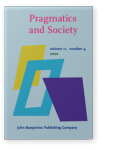Vol. 11:4 (2020) ► pp.505–523
Maji ssu ka? Isn’t that honorific?
Ambiguity of New Japanese honorific ssu
Japanese honorifics used by younger generations are dynamic sites of tensions and discrepancies due to disagreeable conceptions and interpretations among different generations and social groups. It has become a social issue in modern Japanese society often described as keigo no midare ‘disorder in honorific’. This article examines the increased use of ssu by young Japanese speakers as a substitution of the polite form copular desu. This honorific expression plays a role as a relatively new polite form to convey ambivalent emotions to express respect and concurrently their desire to seek affinity and engagement. By analysing Japanese fictions, popular cultures and online-blog comments on the use of ssu, we demonstrate diversity in the social perception of this new honorific.
Article outline
- 1.Introduction
- 2.Derivation of New Japanese honorific ssu
- 3.Intimacy in the expression ssu
- 4.Identity of new honorific ssu users
- 5.Linguistic ideology and social criticisms in new honorific ssu
- 6.Conclusions
- Notes
-
References
